As our days get busier, we are far more likely to reach for pre-packaged mixes and other convenience foods to lighten our load and make dinner prep a bit easier. These are some of my favorite homemade kitchen helpers you can make in advance and keep handy for those extra-hectic evenings… or even the non-hectic ones. Work smarter, not harder!
It’s that time of year again!
Temperatures are finally starting to cool off a bit and leaves are getting their first red and gold tinges, signaling that summer is on its way out the door.
At my house, that also means it’s time to load up on our favorite culinary flavoring, medicinal herb and vampire repellant: fermented garlic.
A true super food
I’ve heard more than one herbalist comment that garlic is their “desert island” herb. If they could only have one, Allium sativum would be their choice every time.
This gets no argument from me. I think garlic should be its own food group. ♥
Beyond its culinary versatility, garlic is famous for its immune-boosting properties. In addition to its ability to fight off bacteria, viruses, fungi and other microbials, garlic also strengthens and stimulates the body’s immune defenses. Taking garlic at the onset of symptoms is tried and true way to shorten the duration of an illness.
It’s also a well-studied cardioprotective, known to help reduce oxidative stress and relax the blood vessels. Garlic is a natural blood thinner that can lower blood pressure and prevent clotting.
Garlic’s anti-inflammatory and antioxidant actions may also be the reason that consuming fresh garlic daily has been shown to reduce your risk of certain types of cancer.
Fermented garlic
Garlic in all its forms offers health benefits, and fermented garlic is no exception. There are many articles online touting the superiority of this garlic preparation over that one — fresh-raw, vs cooked, vs macerated in oil vs macerated in honey vs lacto-fermented vs black garlic — they all have pros and cons and, like most things, there are tradeoffs.
For me, it mostly comes down to the convenience. Fermented garlic offers much of the convenience of pre-peeled, store-bought garlic in a jar, while retaining most of the health benefits of fresh, plus some added bonuses.
For example, studies suggest that fermenting may boost garlic’s antioxidant activity as much as 13x, thanks to increased polyphenols. Fermented garlic contains vitamin K2, which is not present in unfermented garlic. It also has higher levels of amino acids, riboflavin and vitamin E than fresh-raw garlic, but lower levels of vitamin C and thiamin.
There are a number of studies exploring how fermenting affects garlic’s bioactive constituents. One study showed garlic’s volatile compounds and alliin was not affected by fermentation, while another showed alliin decreased.
Alliin is significant because it’s the compound from which allicin — the constituent credited with many of garlic’s health benefits — is derived. Allicin is formed from alliin through an enzymatic transformation when a garlic clove’s cells are crushed via cooking, chopping, mincing or chewing. Allicin is a highly unstable compound that, once created, is easily degraded by heat, light and oxygen — all of which are factors present during fermentation.
Allicin is also one of the main compounds responsible for garlic’s garlicky smell and taste. Fermenting tends to mellow out garlic’s flavor, so despite the studies to the contrary, I think it’s very likely that allicin is reduced at least somewhat during fermentation.
The lost allicin may not be a bad thing, though! The degradation of allicin produces new sulfur-containing compounds, which have health benefits of their own. According to Paul Bergner, author of The Healing Power of Garlic, “Allicin’s breakdown turns garlic into an entire pharmacy of new medicinal constituents.”
Fermentation can make garlic more digestible and makes certain minerals and nutrients more bioavailable and absorbable by the body — potentially great news for those with sensitive tummies, IBS, GERD or FODMAP intolerance.
Fermented garlic is a probiotic food, containing beneficial bacteria (lactobacillus) that will help to keep your microbiome balanced and happy. The bacteria convert plant sugars into lactic acid, a natural preservative that inhibits the growth of harmful bacteria that promote spoilage. Combine that with garlic’s natural prebiotic fiber, and you’ve got yourself quite a potent combination!
Fermenting is also a great way to preserve your garden garlic for the season, since fermented garlic will last in the refrigerator for up to a year.
(It’ll be gone long before that, though, trust me!)
Fresh vs garlic in a jar
Before I understood that there’s a whole universe of difference between garlic that comes in a jar vs fresh, I was a loyal fan of store-bought garlic in a jar. It was a simple, no-brainer way to ensure that I always had *air quotes* “fresh” garlic on hand.
Sure, I had to use 2-3 times as much to approximate the flavor of a fresh clove of garlic (thanks to the lost allicin), but not having to peel and chop/mince my own garlic and simply scoop it out of a jar was just too darn convenient to give up.
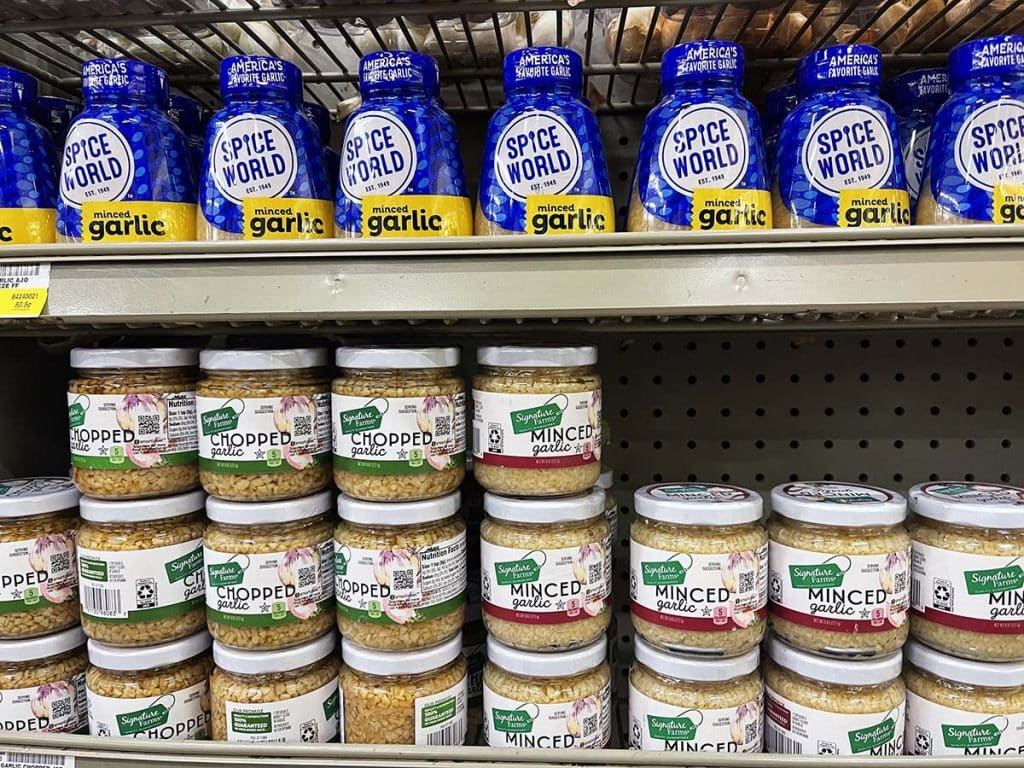
Pasteurization enables garlic to sit on a store shelf for over a year without spoiling, but so much flavor is lost in the process, not to mention most of the health benefits of living, fresh garlic.
Not even close:

Why ferment so much garlic all at once?
I like to ferment garlic outdoors. These suckers are potent during the fermentation stage. Phew. Seriously, it’s the strongest smelling ferment I’ve ever done.
It makes your entire house smell like garlic.
It makes the wallpaper peel.
It makes Mr. Redheaded Herbalist threaten to run away from home.
I’ve tried tucking my ferments away in a closed off back bedroom, but before long, the intense scent of garlic *will* start to permeate the house. I’ve learned through trial and error that it’s far better to do this ferment outdoors, and that means waiting for milder “room” temperatures. Highs in the lower 70s is about right.
Because of our need for ferment-friendly outdoor temps, I try to process enough garlic in the spring and fall to get us through the hot/cold seasons.
Yes, I made four quarts. A gallon of garlic cloves.
Yes, there are only two of us living here.
…what?
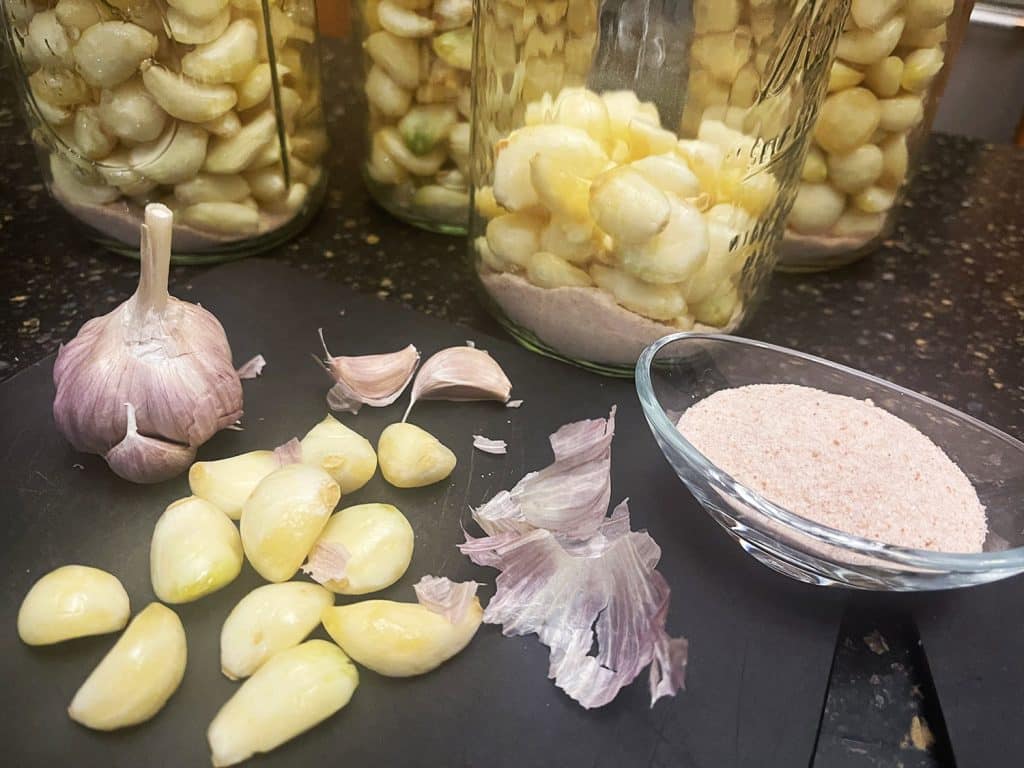
Fermenting helpers
Airlocks are not strictly necessary to a successful ferment, but they do make things easier. You don’t have to monitor your ferments as closely and there’s no need to remember to “burp” your jars daily to prevent the off-gassing from building up too much pressure.
Take it from someone who’s had kombucha ferments explode on more than one occasion… and has marks on the kitchen ceiling to prove it.
Airlocks are a good thing.
I’ve used a variety of different airlocks over the years, from these inexpensive plastic styles to a party balloon stretched over the mouth of the jar. These waterless airlocks from Trellis + Co. are my favorite so far. They’re made from high-quality stainless steel with a simple silicone valve. Easy to use, easy to clean and they just work.
It’s also useful to invest in a set of glass fermenting weights to help hold your ferment submerged under the brine. Trellis + Co. also sells a nifty stainless spring style fermentation weight that uses a compressed coil to hold the ferment under the brine.
Not directly fermenting related, but another indispensable tool is my trusty garlic roller for peeling garlic quickly without damaging the cloves. Just stick several cloves inside the silicone sleeve and roll until the paper wrappers fall off (almost) on their own. Such a simple tool, but it makes a big difference, especially when you need to process a lot of garlic at once.
Another tool-free trick to peeling garlic more easily is to soak your unpeeled cloves in a bowl of warm, unchlorinated water for an hour or so. It loosens the paper skins and helps them to come off more easily.
Using fermented garlic
This is the easy part. Use your fermented garlic anywhere you’d normally use a fresh clove. So that’s to say on EVERYthing…
Chop it up and put it in your salads. This is my favorite way to use fermented garlic!
Add minced garlic to savory sauces, marinades and salad dressings.
Sliced garlic makes a killer pizza topping. (Try it on zucchini pizzas!)
Throw chopped fermented garlic into soups, casseroles and stir fries (add after cooking to avoid deactivating the probiotics).
Make a compound butter with fermented garlic and chives.
Add it to bruschetta or an Italian dipping oil for crusty bread.
Use it in dips like fresh salsa, hummus or pesto.
I could go on, but you probably get the idea. ♥
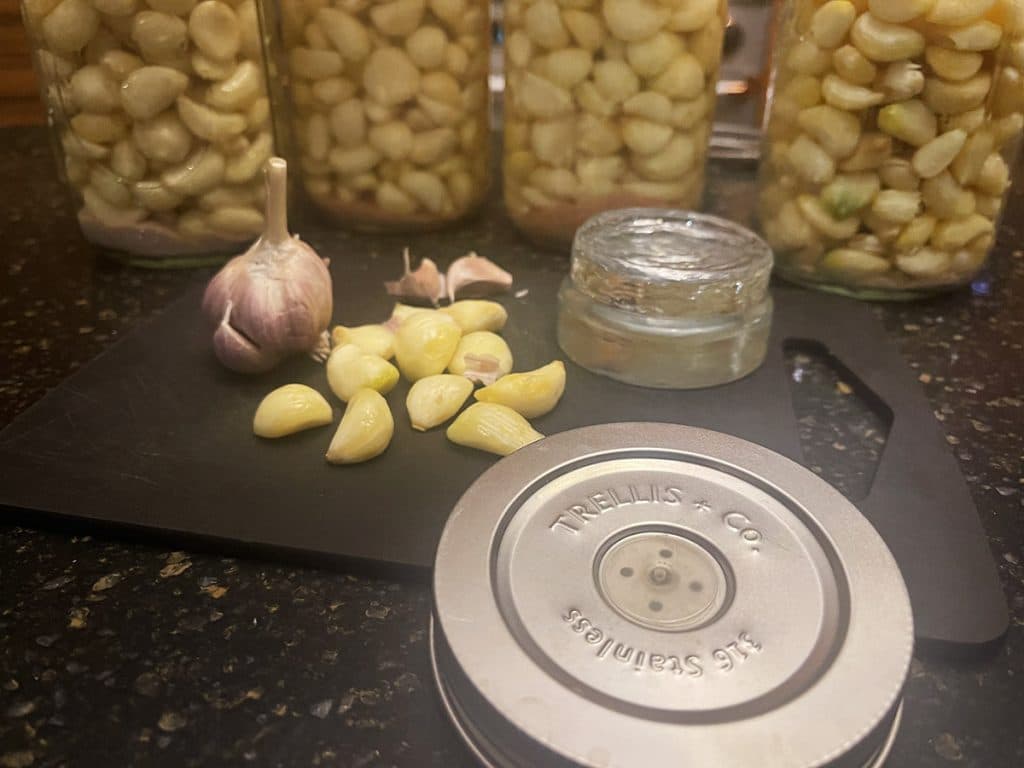
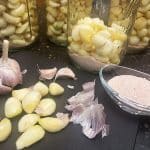
Fermented Garlic
5 Stars 4 Stars 3 Stars 2 Stars 1 Star
No reviews
Instructions
- Fill a 1-quart mason jar with peeled garlic cloves, leaving at least 1” of head space.
- Add salt and cover with filtered, unchlorinated water, making sure the cloves are all completely submerged. Use a fermentation weight if you have one.
- Add an airlock. If you are not using an airlock, you’ll need to “burp” the jar daily, to prevent the off-gassing from building up too much pressure.
- Allow garlic to ferment for 3 to 4 weeks before moving to cold storage.

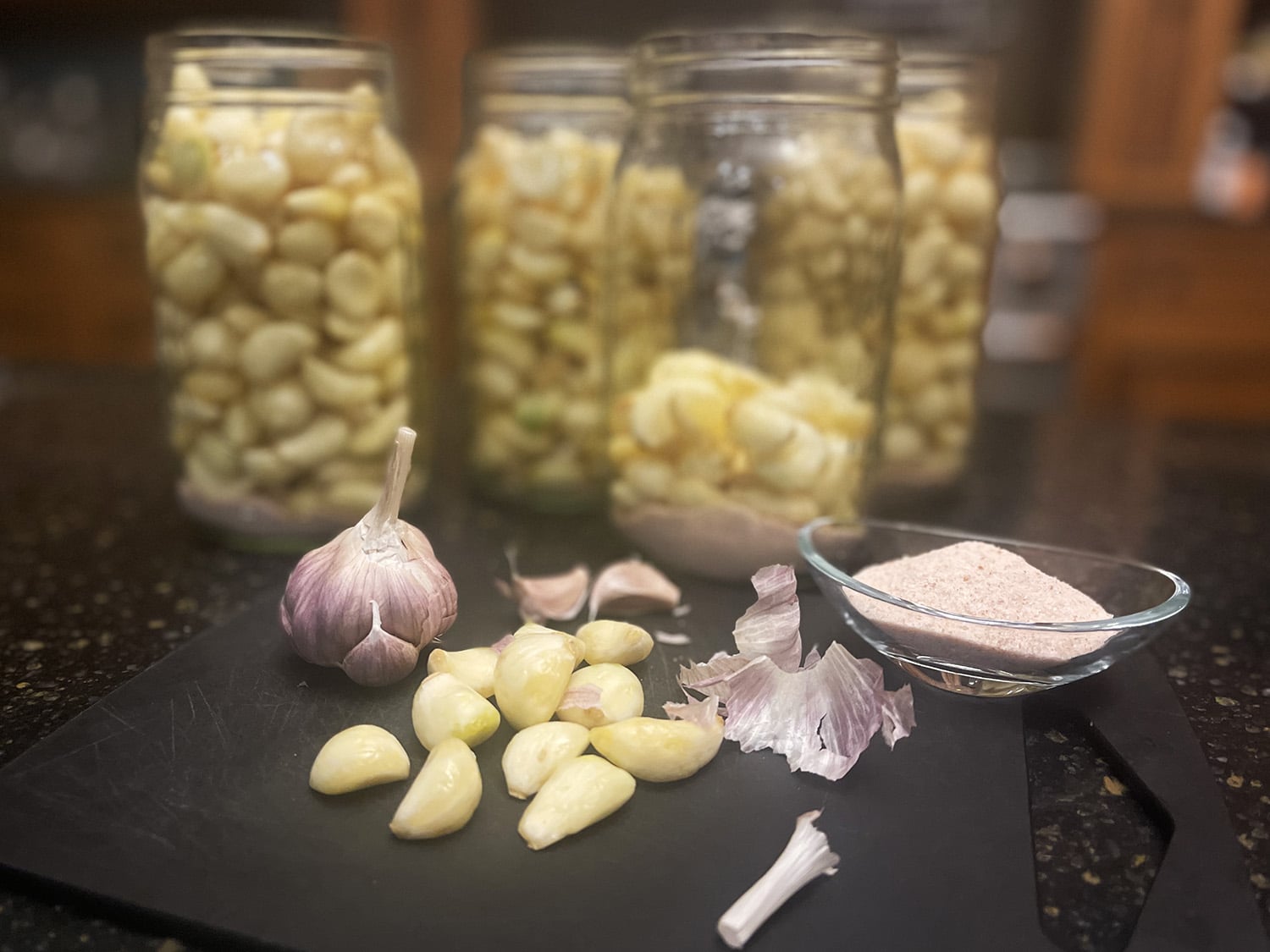

One Response
Hi there
Will Celtic sea salt be okay to ferment garlic?
And, what is the minimum amount of garlic cloves needed?
Necessary to fill garlic all but an inch from the top?
Please email
tysonmacinnis@hotmail.com
Appreciate it